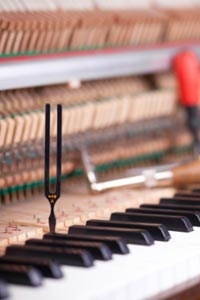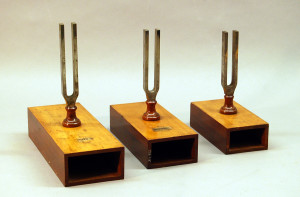What is musical temperament?
In a very small nutshell, musical temperament is making adjustments in the distance between notes so that chords and scales have a halfway decent chance of sounding in tune. Our current system of tuning, equal temperament (where the distance between all notes is equal), is not at all in tune. But, as a society, we’re used to it. What’s cool is that some electronic keyboards are now coming out with the ability to change temperament so the performer can get an idea of what a piece of music sounds like as Bach or Mozart would have actually heard it.
 To make a long story short, it’s nearly impossible to have perfect tuning on a keyboard instrument unless you want to play in one key with minimal notes used outside that particular key. You’d tune your instrument in either well temperament, just intonation or mean-tone, for that key. This then makes that particular key signature sound amazing. However, musicians found it was rather boring to use the same chords and keys over and over and began to desire extreme changes within the music, which wasn’t possible in the temperaments at that time without sounding extremely bad. I believe this is one of the reasons we finally conformed to equal temperament. It’s not perfect but it’s possible to play in all 24 major and minor keys without being totally grossed out by horrible tuning. They even had a term for poorly out of tune notes and keys called “wolf” tones.
To make a long story short, it’s nearly impossible to have perfect tuning on a keyboard instrument unless you want to play in one key with minimal notes used outside that particular key. You’d tune your instrument in either well temperament, just intonation or mean-tone, for that key. This then makes that particular key signature sound amazing. However, musicians found it was rather boring to use the same chords and keys over and over and began to desire extreme changes within the music, which wasn’t possible in the temperaments at that time without sounding extremely bad. I believe this is one of the reasons we finally conformed to equal temperament. It’s not perfect but it’s possible to play in all 24 major and minor keys without being totally grossed out by horrible tuning. They even had a term for poorly out of tune notes and keys called “wolf” tones.
Speaking of being bored with the same keys and chords, I find it fascinating that we’ve gone back to simplistic use of chords. Go into YouTube and type in “four chord songs” and you’ll find some entertaining videos of people demonstrating over 100 rock tunes that use the same four chords. Potentially, we could tune instruments to a temperament that would make these four chord songs sound fairly decent. Assuming that musicians stay in the keys of C, D, F, or G, Bach’s version of “well temperament” would work nicely for many of today’s rock songs! Guitar players would have to stay away from using the capo for the key of F… just saying.
Our problem today? So many ensembles include keyboard instruments so we have no choice but to tune to a keyboard, which determines how instrument makers build all instruments. All musical instruments from the early 20th century onward are now tuned to equal temperament as a general standard. Basically, our music is out of tune unless you play an instrument (or sing) that has the ability to be adjusted as the performer chooses (strings, woodwinds, and brass instruments). However, it requires a musician who knows and understands which notes in a given key signature, scale and/or chord tend to be out of tune. This is where some solid music theory is very helpful.
As early as the time of Bach, equal temperament was introduced but not accepted. Most musicians until the late 1880’s used a form of well-temperament or mean-tone tuning. Again, equal temperament is where the distance between every note is mathematically the same. Other temperaments (just intonation, Pythagorean tuning, mean-tone, well-tempered, etc.) vary in the distance between notes. The only interval in the equal tempered scale that’s right on the money is the octave. All other intervals (the distance between notes) are going to be slightly off, or out of tune. I believe it was the modern era (20th century) that finally forced musicians to conform to equal temperament because the music being written could only sound half-way decent on instruments tuned to equal temperament. 
How do we tune our instruments? A specific “concert pitch” is set (usually an A or C) and the rest of the instrument is tuned to that one note. Our current standard concert pitch is A=440 meaning that the “A” above middle “C” vibrates at 440 cycles per second. To give you an idea of how instruments are “tempered,” I’ve provided a video of a guy performing a folk song on harpsichord in four keys using two different temperaments; one that Bach used and another typical keyboard tuning of that time. In the first version, the more sharps or flats that are added to the key, the more awful it sounds. They called these “wolf notes” because they “howl” and make you want to grind your teeth in pain. What is cool about this video is that he plays the same tune in several different keys so you can actually hear how in tune (or out of tune) a piece of music is when he changes keys! Once he adjusts the temperament (lowering or raising specific notes according to Bach’s tuning), he plays the same tune again in the same four keys. You should notice an improvement.
Don’t worry about all the music theory stuff he throws at you with the “Sarabande” piece. Simply listen to it and see if you can hear the difference when he changes specific notes by tempering them so the intervals change slightly.
I suggest that you listen to the video and take some notes on how you think all eight versions of the folk tune sound. Then, pick your favorite version and comment below. Why do you like it? Can you hear the difference in tone color as you listen to the same tune played in a variety of keys? Do you hear the “wolf” notes and keys? Can you say, “ouch!?”
And, if you really want to “nerd out,” I’d recommend going to Bradley Lehman’s website where he goes into very detailed explanations about tuning instruments in the time of Bach. If you click on the VIDEOS page, you can watch how he tunes and tempers a harpsichord (with the aid of his cat) for a variety of purposes. I believe he did this research for his doctoral dissertation.
Here’s the VIDEO where Bradley actually tunes a harpsichord using markings on the score of the “Well Tempered Keyboard” as a means to temper each note of the scale so that all 24 pieces of music in this collection sound decent. If you’ve ever studied classical piano, you’ll know many of these tunes and should be able to hear how they sound different in a version of “well temperament” as opposed to our modern equal tempered tuning.
NOTE: At one time, what we now call “enharmonic” notes (two notes that sound the same but are written differently) were actually two different notes. For example, A-sharp and B-flat were slightly different. The same was true for C-sharp and D-flat and so on. You will notice in the video that he refers to them being two different notes. So, if you’re confused, you’ll know why now.
Happy Listening!
© 2015 by Del Hungerford
[mailerlite_form form_id=2]


[…] answered. First off, it’s necessary to understand the difference between concert pitch and temperament. If you’re not familiar with those, please read the articles. They are NOT the same even […]